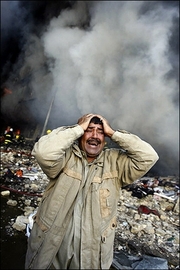Only the Best for Our Troops
Walter Reed has become a disgusting travesty:
Behind the door of Army Spec. Jeremy Duncan's room, part of the wall is torn and hangs in the air, weighted down with black mold. When the wounded combat engineer stands in his shower and looks up, he can see the bathtub on the floor above through a rotted hole. The entire building, constructed between the world wars, often smells like greasy carry-out. Signs of neglect are everywhere: mouse droppings, belly-up cockroaches, stained carpets, cheap mattresses.
This is the world of Building 18, not the kind of place where Duncan expected to recover when he was evacuated to Walter Reed Army Medical Center from Iraq last February with a broken neck and a shredded left ear, nearly dead from blood loss. But the old lodge, just outside the gates of the hospital and five miles up the road from the White House, has housed hundreds of maimed soldiers recuperating from injuries suffered in the wars in Iraq and Afghanistan.
The common perception of Walter Reed is of a surgical hospital that shines as the crown jewel of military medicine. But 5 1/2 years of sustained combat have transformed the venerable 113-acre institution into something else entirely -- a holding ground for physically and psychologically damaged outpatients. Almost 700 of them -- the majority soldiers, with some Marines -- have been released from hospital beds but still need treatment or are awaiting bureaucratic decisions before being discharged or returned to active duty.
They suffer from brain injuries, severed arms and legs, organ and back damage, and various degrees of post-traumatic stress. Their legions have grown so exponentially -- they outnumber hospital patients at Walter Reed 17 to 1 -- that they take up every available bed on post and spill into dozens of nearby hotels and apartments leased by the Army. The average stay is 10 months, but some have been stuck there for as long as two years.






